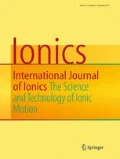Abstract
This work reports the synthesis of a novel carbon supported Au-decorated PdCu composite catalyst for formic acid oxidation. The catalyst was prepared through a two-step process. PdCu alloy was firstly prepared through co-reduction of Pd and Cu ions using ethylene glycol and sodium citrate as the reducing and stabilizing reagents. Au was decorated on the surface of the PdCu alloy through spontaneous replacements of Pd and Cu by Au. Transmission electron microscopy (TEM) image shows that the metallic nanoparticles are well dispersed on the carbon surface. X-ray photoelectron spectroscopy (XPS) results demonstrate that the Pd 3d5/2 binding energy (BE) of the PdCu@Au/C exhibits a positive shift in comparison with that of Pd/C and PdCu/C. The as-prepared composite catalyst exhibits higher activity towards formic acid oxidation in comparison with individual Pd. Interestingly, a significantly improved electrochemical stability of Au-decorated PdCu nanoparticles compared with the PdCu counterpart is observed.







References
Zhu Y, Ha SY, Masel RI (2004) High power density direct formic acid fuel cells. J Power Sources 130:8–14
Babu PK, Kim HS, Chung JH, Oldfield E, Wieckowski A (2004) Bonding and motional aspects of CO adsorbed on the surface of Pt nanoparticles decorated with Pd. J Phys Chem B 108:20228–20232
Liu Z, Hong L, Tham MP, Lim TH, Jiang H (2006) Nanostructured Pt/C and Pd/C catalysts for direct formic acid fuel cells. J Power Sources 161:831–835
Wang X, Tang Y, Gao Y, Lu TH (2008) Carbon-supported Pd-Ir catalyst as anodic catalyst in direct formic acid fuel cell. J Power Sources 175:784–788
Chen J, Li Y, Liu S, Wang G, Tian J, Jiang C, Zhu S, Wang R (2013) Remarkable activity of PdIr nanoparticles supported on the surface of carbon nanotubes pretreated via a sonochemical process for formic acid electro-oxidation. Appl Surf Sci 287:457–460
Wang XM, Xia YY (2008) Electrocatalytic performance of PdCo/C catalyst for formic acid oxidation. Electrochem Commun 10:1644–1646
Li RS, Hao H, Cai WB, Huang T, Yu AS (2010) Preparation of carbon supported Pd-Pb hollow nanospheres and their electrocatalytic activities for formic acid oxidation. Electrochem Commun 12:901–904
Qin Y, Jiang JY, Niu D, Zhang X, Zhou X, Niu L, Yuan W (2012) Carbon nanofiber supported bimetallic PdAu nanoparticles for formic acid electrooxidation. J Power Sources 215:130–134
Lee S, Jung N, Cho J, Park H, Ryu J, Jang I, Kim H, Cho E, Park Y, Ham HC, Jang J, Yoo SJ (2014) Surface-rearranged Pd3Au/C nanocatalysts by using CO-induced segregation for formic acid oxidation reactions. ACS Catal 4:2402–2408
Ding K, Liu L, Cao Y, Yan X, Wei H (2014) Formic acid oxidation reaction on a PdxNiy bimetallic nanoparticle catalyst prepared by a thermal decomposition process using ionic liquids as the solvent. Int J Hydrog Energy 39:7326–7337
Bai Z, Yang L, Zhang J, Li L, Lv J, Hu C, Zhou J (2010) Solvothermal synthesis and characterization of Pd-Rh alloy hollow nanosphere catalysts for formic acid oxidation. Catal Commun 11:919–922
Lu Y, Chen W (2012) PdAg alloy nanowires: facile one-step synthesis and high electrocatalytic activity for formic acid oxidation. ACS Catal 2:84–90
Wen W, Li C, Li W, Tian Y (2013) Carbon-supported Pd-Cr electrocatalysts for the electrooxidation of formic acid that demonstrate high activity and stability. Electrochim Acta 109:201–206
Xu C, Liu Y, Wang J, Geng H, Qiu H (2012) Nanoporous PdCu alloy for formic acid electro-oxidation. J Power Sources 199:124–131
Wang L, Zhai J, Jiang K, Wang J, Cai W (2015) Pd-Cu/C electrocatalysts synthesized by one-pot polyol reduction towards formic acid oxidation: structural characterization and electrocatalytic performance. Int J Hydrog Energy 40:1726–1734
Lu L, Shen L, Shi Y, Chen T, Jiang G, Ge C, Tang Y, Chen Y, Lu T (2012) New insights into enhanced electrocatalytic performance of carbon supported Pd-Cu catalyst for formic acid oxidation. Electrochim Acta 85:187–194
Li S, Cheng D, Qiu X, Cao D (2014) Synthesis of Cu@Pd core-shell nanowires with enhanced activity and stability for formic acid oxidation. Electrochim Acta 143:44–48
Ren M, Zhou Y, Tao F, Zou Z, Akins DL, Yang H (2014) Controllable modification of the electronic structure of carbon supported core-shell Cu@Pd catalysts for formic acid oxidation. J Phys Chem C 118:12669–12675
Hu S, Scudiero L, Ha S (2012) Electronic effect on oxidation of formic acid on supported Pd-Cu bimetallic surface. Electrochim Acta 83:354–358
Dai L, Zou S (2011) Enhanced formic acid oxidation on Cu-Pd nanoparticles. J Power Sources 196:9369–9372
Zhang J, Sasaki K, Sutter E, Adzic RR (2007) Stabilization of platinum oxygen-reduction electrocatalysts using gold clusters. Science 315:220–222
Suo Y, Hsing I-M (2011) Synthesis of bimetallic PdAu nanoparticles for formic acid oxidation. Electrochim Acta 56:2174–2183
Wang D, Lin H, Wang H, Yu Y, Rus E, Muller DA, DiSalvo FJ, Abruña HD (2012) Facile synthesis of carbon supported Pd-Co core-shell nanoparticles as oxygen reduction electrocatalysts and their enhanced activity and stability with monolayer Pt decoration. Chem Mater 24:2274–2281
Antelman MS, Jr FJH (1982) The encyclopedia of chemical electrode. Plenum Press, New York, Potentials
Jenkins R, Snyder RL (1996) Introduction to X-ray powder diffractometry. Wiley, New York
Hong W, Wang J, Wang E (2014) Facile synthesis of highly active PdAu nanowire networks as self-supported electrocatalyst for ethanol electrooxidation. ACS Appl Mater Inter 6:9481–9487
Acknowledgments
This work is financially supported by the Zhejiang Provincial Natural Science Foundation of China (LQ16B030001), the Project of Interdisciplinary Research in Zhejiang University of Science and Technology (2015JC02Y), the National Natural Science Foundation of China (51206148), and the Zhejiang Provincial Science and Technology Major Project (2013C03017-4). We are thankful for the financial support of China Scholarship Council (201308330369).
Author information
Authors and Affiliations
Corresponding author
Rights and permissions
About this article
Cite this article
Suo, Y., Zhang, Z., He, J. et al. Synthesis of carbon supported Au-decorated PdCu nanocatalyst for formic acid oxidation. Ionics 22, 985–990 (2016). https://doi.org/10.1007/s11581-016-1718-x
Received:
Revised:
Accepted:
Published:
Issue Date:
DOI: https://doi.org/10.1007/s11581-016-1718-x

